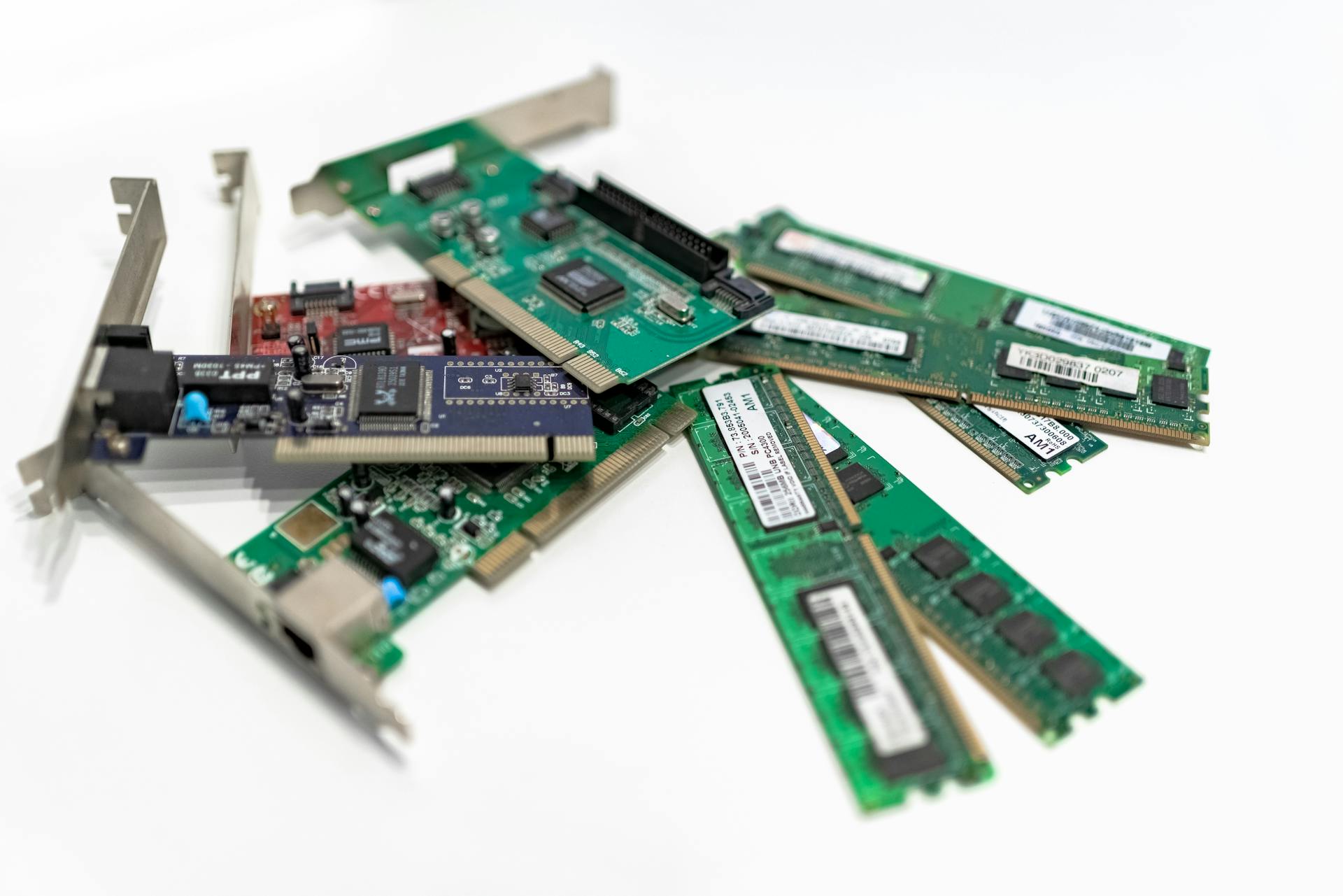
The PCI DSS framework is a set of standards designed to ensure that organizations handling credit card information maintain a secure environment. It's a must-have for any business that wants to accept credit card payments.
The framework consists of 12 main requirements, which are divided into six categories: building and maintaining a secure network, protecting cardholder data, maintaining a vulnerability management program, implementing strong access control measures, regularly monitoring and testing networks, and maintaining an information security policy.
The PCI DSS framework requires organizations to implement a range of security controls, including firewalls, intrusion detection systems, and encryption. This is to prevent unauthorized access to sensitive cardholder data.
By following the PCI DSS framework, organizations can significantly reduce the risk of data breaches and protect their customers' sensitive information.
Take a look at this: Pci Compliance Issues with Credit Card Authroization Forms
Key Components
The PCI DSS framework is built around several key components that help safeguard sensitive cardholder data. The primary goal of PCI DSS is to minimize the risk of data breaches, fraud, and identity theft.
Additional reading: Card Data Covered by Pci Dss Includes
One of the key components of PCI DSS is its focus on industry best practices for processing, storing, and transmitting credit card data. This ensures that businesses adhere to established standards and guidelines.
By following PCI DSS, businesses can foster trust among customers and stakeholders, which is essential for building a strong reputation and customer loyalty.
Purpose of PCI DSS
The primary goal of PCI DSS is to safeguard and optimize the security of sensitive cardholder data. This includes credit card numbers, expiration dates, and security codes.
Compliance with PCI DSS minimizes the risk of data breaches, fraud, and identity theft. By following the standard's security controls, businesses can protect their customers' sensitive information.
The standard ensures businesses adhere to industry best practices when processing, storing, and transmitting credit card data. This fosters trust among customers and stakeholders.
Here's an interesting read: Pci Dss Information Security Policy
Map Your Flows
First, you need to know where sensitive credit card data lives and how it gets there. This involves creating a comprehensive map of the systems, network connections, and applications that interact with credit card data across your organization.
A different take: First Data Pci Compliance
To start, identify every consumer-facing area of the business that involves payment transactions. This may include online shopping carts, in-store payment terminals, or orders placed over the phone.
You'll also want to pinpoint the various ways cardholder data is handled throughout the business. This includes knowing exactly where the data is stored and who has access to it.
Internal systems or underlying technologies that touch payment transactions need to be identified. This includes network systems, data centers, and cloud environments.
Here's a breakdown of the key areas to map:
- Consumer-facing areas: online shopping carts, in-store payment terminals, orders over the phone
- Cardholder data handling: where data is stored and who has access to it
- Internal systems: network systems, data centers, cloud environments
Validation
Validation is a crucial step in ensuring PCI compliance. Organizations must complete a PCI validation form annually, regardless of how card data is accepted.
Payment processors may request PCI compliance as part of their required reporting to the payment card brands. Business partners may also request it as a prerequisite to entering into business agreements.
For platform businesses, customers may request PCI compliance to show their customers that they are handling data securely. This is especially important for online transactions among multiple distinct sets of users.
Here's an interesting read: Pci Compliance for Storing Credit Card Information
The PCI DSS security standard includes 12 main requirements with more than 300 sub-requirements that mirror security leading practices. To make it easier for new businesses to validate PCI compliance, the PCI Council created nine different forms or Self-Assessment Questionnaires (SAQs).
There are multiple types of SAQ, each with a different length depending on the entity type and payment model used. Each SAQ question has a yes-or-no answer, and any "no" response requires the entity to indicate its future implementation.
To determine which SAQ is applicable, organizations must consider their entity type and payment model. They can also hire a PCI Council-approved auditor to verify that each PCI DSS security requirement has been met.
Here are the three scenarios in which an organization could be asked to show that it is PCI compliant:
- Payment processors may request it as part of their required reporting to the payment card brands.
- Business partners may request it as a prerequisite to entering into business agreements.
- For platform businesses, customers may request it to show their customers that they are handling data securely.
Benefits and Challenges
PCI DSS compliance offers several advantages for businesses. Complying with PCI DSS ensures the security of cardholder data, helping businesses build and maintain trust with customers.
Enhanced customer trust is one of the key benefits of PCI DSS compliance. This can lead to repeat business, as well as increased customer and brand loyalty.
Reducing the risk of data breaches is another significant advantage. PCI DSS' security controls and data protection procedures minimize the risk of data breaches and the associated costs, such as fines, legal fees, and reputational damage.
Fraud protection is also a major benefit of PCI DSS compliance. PCI DSS requirements prevent and detect fraud, reducing the risk of financial loss connected to fraud.
Compliance with industry standards is a valuable byproduct of PCI DSS compliance. This demonstrates a commitment to industry best practices that improve a business's standing with partners, stakeholders, and regulators.
Here are the key benefits of PCI DSS compliance:
- Enhanced customer trust
- Reduced risk of data breaches
- Fraud protection
- Compliance with industry standards
Security Controls
Implementing robust security controls is crucial for protecting sensitive credit card data. PCI DSS Requirement 6 emphasizes the importance of identifying and classifying security vulnerabilities through reliable external sources.
For your interest: Cyber Security Pci Compliance
To limit the potential for exploits, organizations must deploy critical patches in a timely manner and patch all systems in the card data environment, including operating systems, firewalls, routers, switches, application software, databases, and POS terminals.
To ensure the right security configurations and protocols are in place, organizations should work with IT and security teams to implement security controls and protocols, such as Transport Layer Security (TLS).
Here's a list of the 12 security requirements for PCI DSS that organizations should focus on:
- Requirement 1: Install and maintain a firewall configuration to protect cardholder data
- Requirement 2: Do not use vendor-supplied defaults for system passwords and other security parameters
- Requirement 3: Protect stored cardholder data
- Requirement 4: Encrypt transmission of cardholder data across open, public networks
- Requirement 5: Use and regularly update antivirus software
- Requirement 6: Develop and maintain secure systems and applications
- Requirement 7: Restrict access to cardholder data by business need-to-know
- Requirement 8: Assign a unique ID to each person with computer access
- Requirement 9: Restrict physical access to cardholder data
- Requirement 10: Track and monitor all access to network resources and cardholder data
- Requirement 11: Regularly test security systems and processes
- Requirement 12: Maintain a policy for information security
Check Controls
To ensure the security of credit card data, it's essential to check your security controls and protocols. This involves working with IT and security teams to guarantee the right configurations and protocols are in place.
You'll need to map out all the potential touchpoints for credit card data across your organization, as this will help you identify where security controls are needed. This includes all systems, laptops, and devices that store, process, or transmit credit card data.
Transport Layer Security (TLS) is a key protocol for securing the transmission of data. This is because it encrypts data in transit, making it unreadable to anyone intercepting it.
To meet PCI DSS requirements, you'll need to ensure that sensitive data is protected. This includes encrypting cardholder data using industry-accepted algorithms, such as AES-256 or RSA 2048.
Card data discovery tools can be helpful in identifying where unencrypted primary account numbers (PAN) are stored. This is crucial, as storing unencrypted PANs can put your organization at risk.
Encrypting cardholder data prior to transmitting it across public networks is also essential. This can be done using secure transmission protocols, such as TLS or SSH.
Use Anti-Virus Software
Protecting your systems from malware is crucial, and that's where anti-virus software comes in. You must deploy anti-virus solutions on all systems, including workstations, laptops, and mobile devices that employees use to access the system, both locally and remotely.
Anti-virus software must be regularly updated to detect known malware. This will prevent known malware from infecting systems. Updates should be done on a regular basis to ensure the software stays effective.
Ensure anti-virus mechanisms are always active, using the latest signatures, and generating auditable logs. This will help you track any potential issues and ensure your systems remain secure.
Here's a list of what you need to do to stay on top of anti-virus software:
- Deploy anti-virus solutions on all systems, including workstations, laptops, and mobile devices.
- Regularly update anti-virus software to detect known malware.
- Ensure anti-virus mechanisms are always active, using the latest signatures, and generating auditable logs.
Access by Need to Know
Access by Need to Know is a fundamental concept within PCI DSS, which grants access to card data and systems on a need-to-know basis. This approach helps prevent exposure of sensitive data to those who don't need it.
To implement strong access control measures, service providers and merchants must be able to allow or deny access to cardholder data systems. This is all about role-based access control (RBAC).
Access control systems must assess each request to prevent exposure of sensitive data to those who don't need it. This means having a documented list of all users with their roles, who need to access card data environments.
Intriguing read: How Do I Know If I Am Pci Compliant
This list must contain each role, its definition, current privilege level, expected privilege level, and data resources for each user to perform operations on card data. It's crucial to have this documentation in place.
Two-factor authorization is required for all non-console administrative access, which adds an extra layer of security to prevent unauthorized access. This ensures that whenever someone accesses cardholder data, that activity can be traced to a known user.
Worth a look: Pci Dss Level 4
Restrict Physical Access
Restricting physical access to cardholder data is crucial to prevent unauthorized access to systems and data. This is where video cameras and electronic access control come into play, monitoring entry and exit doors of physical locations like data centres.
You'll need to retain recordings or access logs of personnel movement for at least 90 days. This helps in identifying any potential security breaches.
Implementing an access process that distinguishes between authorized visitors and employees is a must. This will help in preventing unauthorized access to sensitive areas.
All removable or portable media containing cardholder data must be physically protected, and destroyed when the business no longer needs it. This is a simple yet effective way to prevent data breaches.
Correct audit policies must be set on all systems, and logs must be sent to a centralized syslog server. This will help in monitoring system and network activities.
Security Information and Event Monitoring tools (SIEM) can help in logging system and network activities, monitoring logs, and alerting suspicious activity. This is a powerful tool in detecting potential security threats.
Audit trail records must meet a certain standard in terms of the information contained, and time synchronization is required. This ensures that all logs are synchronized and can be easily reviewed.
Audit data must be secured and maintained for a period no shorter than a year. This is a critical step in ensuring that all security incidents are properly documented and investigated.
For more insights, see: Pci Compliance File Integrity Monitoring
Policy for Personnel Information
To maintain a secure environment, it's essential to have a policy in place that addresses information security for all personnel. This policy must be reviewed at least once a year and disseminated to all employees, vendors, and contractors.
The policy should include requirements such as annual risk assessments, user awareness training, employee background checks, and incident management. These measures are crucial in identifying and mitigating potential threats to sensitive information.
A formal risk assessment should be conducted annually to identify critical assets, threats, and vulnerabilities. This process helps organizations understand their potential risks and take necessary steps to address them.
User awareness training is also a vital component of a comprehensive information security policy. This training should educate employees on the importance of information security and their role in maintaining it.
Employee background checks are another essential aspect of a robust information security policy. This helps organizations ensure that only trustworthy individuals have access to sensitive information.
Consider reading: Pci Dss Courses
Incident management is also a critical aspect of an information security policy. This process helps organizations respond quickly and effectively to security incidents, minimizing the potential damage.
The following elements are required to be part of an information security policy:
- An annual, formal risk assessment that identifies critical assets, threats, and vulnerabilities.
- User awareness training
- Employee background checks
- Incident management
Web Application Firewalls
A web application firewall, or WAF, is a crucial security control that can safeguard your online presence against malicious attacks. It works by inspecting all incoming traffic and filtering out malicious requests.
To ensure PCI compliance, a WAF can be used to secure data against common web application attack vectors, including SQL injections and RFIs. This is in line with PCI DSS Requirement 6.6, introduced in 2008.
There are two ways to satisfy this requirement: through application code reviews or by implementing a WAF. Application code reviews involve a manual review of web application source code, coupled with a vulnerability assessment of application security.
A WAF, on the other hand, can be deployed between the application and clients to inspect and filter out malicious traffic. This can be achieved through the use of cloud-based WAFs, such as the one offered by Imperva.
Readers also liked: Pci Dss Requirement 10
Here are some key features of a cloud-based WAF:
- Blocks web application attacks using signature recognition and IP reputation
- Can be configured and ready to use within minutes
- Does not require any hardware installation or management overhead
By implementing a WAF, organizations can ensure that their web applications are secure and compliant with PCI DSS requirements.
Certification and Reporting
To become PCI-compliant, companies must undergo a Report on Compliance (ROC) conducted by a PCI Qualified Security Assessor (QSA). This independent validation provides a detailed explanation of the testing completed and an Attestation of Compliance (AOC) documenting that a ROC has been completed.
The ROC is a crucial step in the certification process, which also includes PCI DSS Certification, a set of requirements established by the PCI SSC to ensure the security of card data. The PCI SSC includes best practices such as installation of firewalls and encryption of data transmissions.
Companies are categorized into four reporting levels based on their annual number of transactions: Level 1 (over six million transactions), Level 2 (between one and six million transactions), Level 3 (between 20,000 and one million transactions, and all e-commerce merchants), and Level 4 (less than 20,000 transactions). Each card issuer maintains a table of compliance levels and a table for service providers.
Consider reading: Pci Dss Levels Merchant
Reporting Levels
Reporting levels play a crucial role in determining how companies prove and report their PCI compliance.
The annual number of transactions and how they're processed are key factors in determining a company's reporting level. An acquirer or payment brand may manually place an organization into a reporting level at its discretion.
Merchant levels are categorized as follows:
Companies must meet specific requirements based on their reporting level, which can impact the frequency and type of compliance assessments they need to complete.
Certifications and Reports
Certifications and Reports are a crucial aspect of maintaining a secure environment for sensitive customer information. A Report on Compliance (ROC) is conducted by a PCI Qualified Security Assessor (QSA) to validate an entity's compliance with the PCI DSS standard.
The ROC results in two documents: a ROC Reporting Template and an Attestation of Compliance (AOC). The AOC documents that a ROC has been completed and the overall conclusion of the ROC.
Intriguing read: Pci Attestation of Compliance
There are various certifications and assessments that can be done, including PCI DSS Certification, CSA STAR Certification, GDPR Assessment, HIPAA Assessment, and HITRUST Certification. Here are some of the certifications and assessments listed:
- PCI DSS Certification
- CSA STAR Certification
- GDPR Assessment
- HIPAA Assessment
- HITRUST Certification
- ISO 27001 Certification
- FedRAMP and 3PAO Services
- MARS-E Assessment
- PCI SSF
- P2PE Certification
- SOC2 Report
A SOC2 Report is also an important certification to have.
Frequently Asked Questions
Is PCI DSS a framework?
PCI DSS is a set of standards, not a framework, but it provides a structured approach to payment security. It's a framework-like structure that guides merchants and financial institutions in implementing security policies and processes.
What are the 6 major principles of PCI DSS?
The 6 major principles of PCI DSS are to ensure network security, protect sensitive data, and implement robust access controls, while also maintaining a vulnerability management program and regularly monitoring and testing systems. By following these principles, organizations can effectively safeguard cardholder data and maintain a secure payment environment.
What is the PCI DSS model?
The PCI DSS model is a set of rules and guidelines to protect credit card information from data breaches and fraud. It's a crucial standard for organizations handling credit card data to ensure security and compliance.
What are the 4 things that PCI DSS covers?
PCI DSS covers four key areas: cardholder data protection, access control, secure network systems, and encrypted data transmission. These areas work together to safeguard sensitive card information and prevent data breaches.
Sources
- https://en.wikipedia.org/wiki/Payment_Card_Industry_Data_Security_Standard
- https://www.techtarget.com/searchsecurity/definition/PCI-DSS-Payment-Card-Industry-Data-Security-Standard
- https://www.controlcase.com/what-are-the-12-requirements-of-pci-dss-compliance/
- https://www.imperva.com/learn/data-security/pci-dss-certification/
- https://stripe.com/guides/pci-compliance
Featured Images: pexels.com


